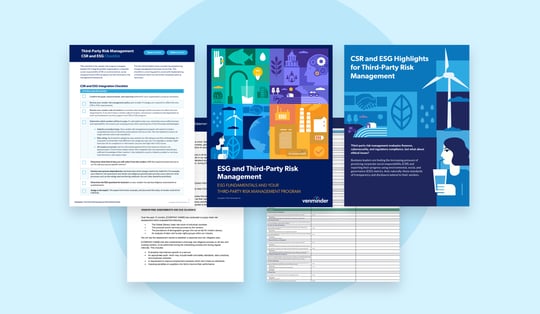Over the past few years, regulators and consumers have intensified the focus on ESG (environmental, social, and governance) issues and are starting to hold organizations accountable. Of the many ESG concerns today, one of the most serious issues within the vendor supply chain is human exploitation, which includes modern slavery, forced labor, and human trafficking. Shockingly, the world's supply chains are rife with human rights abuses, which is prevalent in raw materials, manufacturing, construction, tourism, agriculture, and more.
Unfortunately, your organization may be an unknowing participant in the abuses of people occurring worldwide, thanks to complex supply chains, multiple subcontracting relationships, and unscrupulous third parties. But ignorance is not an acceptable excuse. Organizations must take responsibility for the risk of their third-party relationships.
Read on to learn more about modern slavery, human trafficking, and what your organization can do to prevent these horrific practices in its supply chain.
What Is Modern Slavery?
The legal concept of modern slavery encompasses slavery and slavery-like practices, forced labor, debt bondages, forced marriages, and human trafficking. Human slavery and trafficking refer to situations of exploitation that a person can’t refuse or leave because of threats, violence, coercion, deception, or abuse of power. Modern slavery is a hidden crime that affects every country in the world and has been observed in many industries, including garment manufacturing, mining, agriculture, and settlements for internally displaced people and refugees.
4 Common types of modern slavery are:
- Forced labor occurs when people are threatened with violence and forced to work without pay. Enslaved people are treated as property and exploited to create a product for commercial sale.
- Bonded Labor is the most common form of modern slavery. A person is compelled to work to repay a debt and can't leave until the debt has been paid off. Workers are tricked into debt by paying fees to secure a job (also known as recruitment fees). The workers are forced to sign contracts they don't understand and are paid meager sums by the employer. The employer then claims that the worker's wages are needed to pay off debts, food, and accommodations, making it virtually impossible to repay the original debt.
- Child Labor includes forced labor, domestic servitude, bonded labor, sex trafficking, and child soldiers.
- Domestic Servitude is where the victim may appear to be a maid, a nanny, or another type of domestic help. It crosses the line into slavery when an employer restricts their movements, prevents them from leaving, or confiscates their travel papers. Migrant workers are also frequently vulnerable to domestic servitude situations because unscrupulous recruiters deceive workers into moving abroad and then confiscate their documents.
Many of the products we buy and use daily are produced by people trapped in modern slavery. Some industries have extreme modern slavery and human trafficking risks. Those industries include high-tech, steel, automobiles, agriculture and seafood, mining and mineral, garments and textiles, shipping and transportation, tourism and hotels, and construction. Remember that while those industries have a high risk of human exploitation, any industry or vendor may have a risk for modern slavery or human trafficking.

How Third-Party Risk Management Offers Visibility Into Your Supply Chain
Organizations are exposed to modern slavery and human trafficking through their vendor relationships. Third-party risk management is a practice that can help your organization identify these risks and begin to mitigate them.
Let's explore TPRM activities your organization can use to identify and address modern slavery and human trafficking in the supply chain:
- Identify risks. Conduct vendor assessments to identify and analyze supply chain risks from end to end. Ask specific questions about modern slavery in your vendor risk assessment questionnaire, such as:
- Is the vendor compliant with regulations restricting modern slavery (for example, the Modern Slavery Act of 2015 in the UK or The Victims of Trafficking and Violence Prevention Act (TVPA) in the U.S.)?
- Does the vendor have a modern slavery/human trafficking statement?
- What is the vendor's process for identifying, assessing, and addressing unethical practices such as modern slavery in the organization and in the supply chain?
- Perform due diligence. For individual vendors, request copies of vendor codes of conduct and third-party risk management policies and practices. Require proof of risk assessments and monitoring as well as copies of modern slavery statements and policies. You should also conduct audits of supply chain operations to find out how labor and material is sourced, and the prices paid to suppliers further down the supply chain.
- Create a supplier code of conduct. Implement written policies for suppliers that clearly outline standards and expectations for ethical behavior regarding labor, health and safety, and the environment. Along with a written code of conduct, suppliers can benefit from training that explains their contractual obligations to comply with ethical business standards and practices.
- Monitor your vendors. Set up ESG news alerts for your vendor and their industry and use subscription-based risk monitoring and alert services to provide vendor risk intelligence. If your organization has a program to collect vendor ESG reporting, ensure your vendors provide updated reporting regularly.
Organizations of all sizes have the ethical responsibility to stop the horrific exploitation of human beings. Effective third-party risk management can be instrumental in identifying and ending serious supply chain risks such as modern slavery and human trafficking.





.gif?width=1920&name=Sample-Graphic-Animation%20(1).gif)




